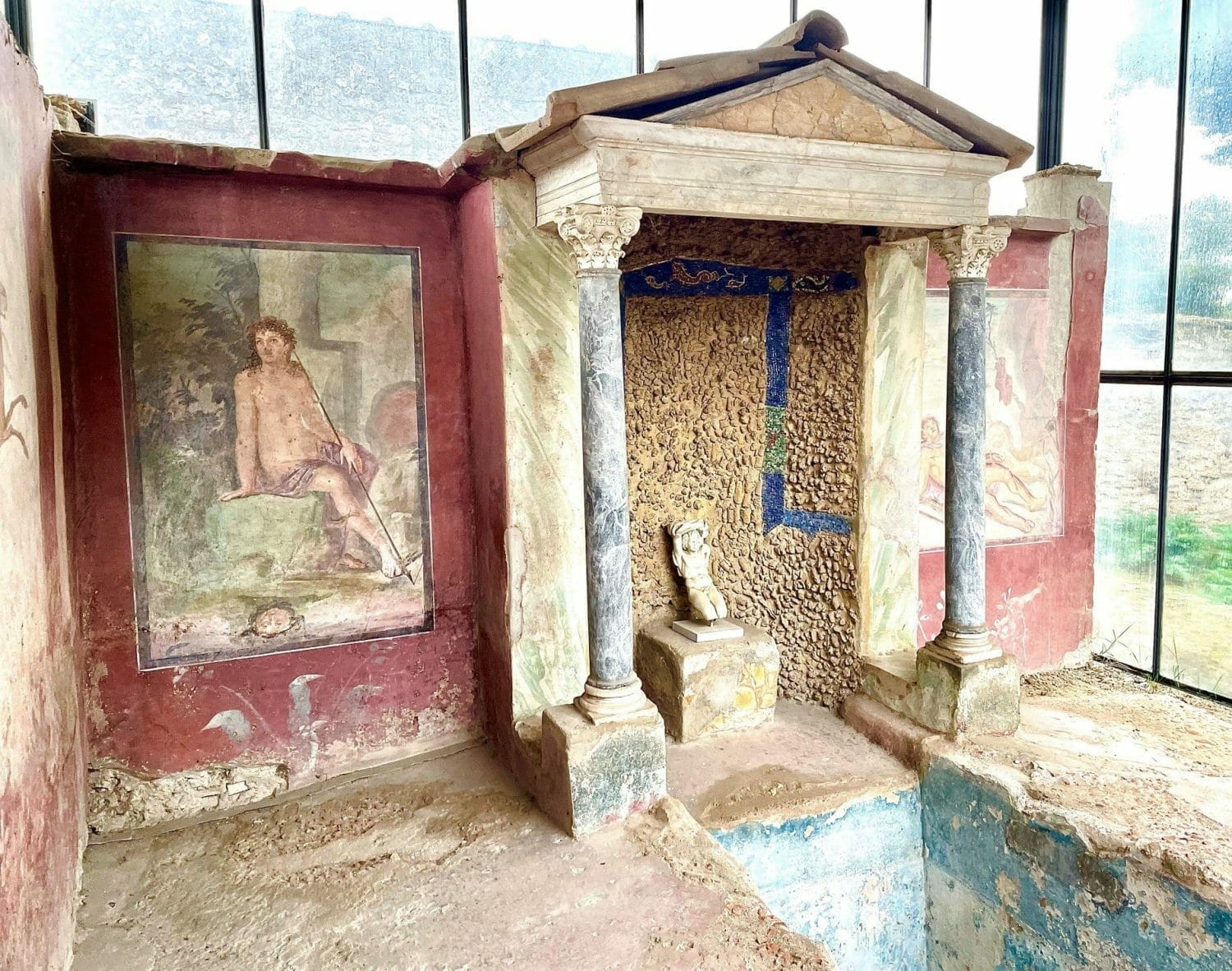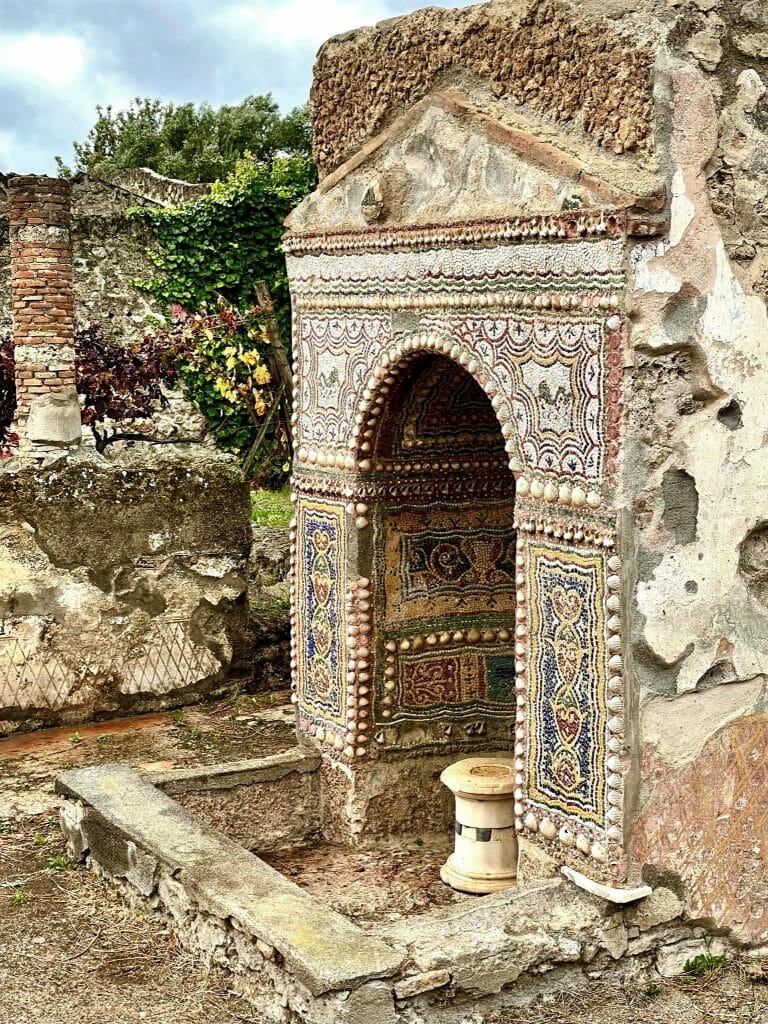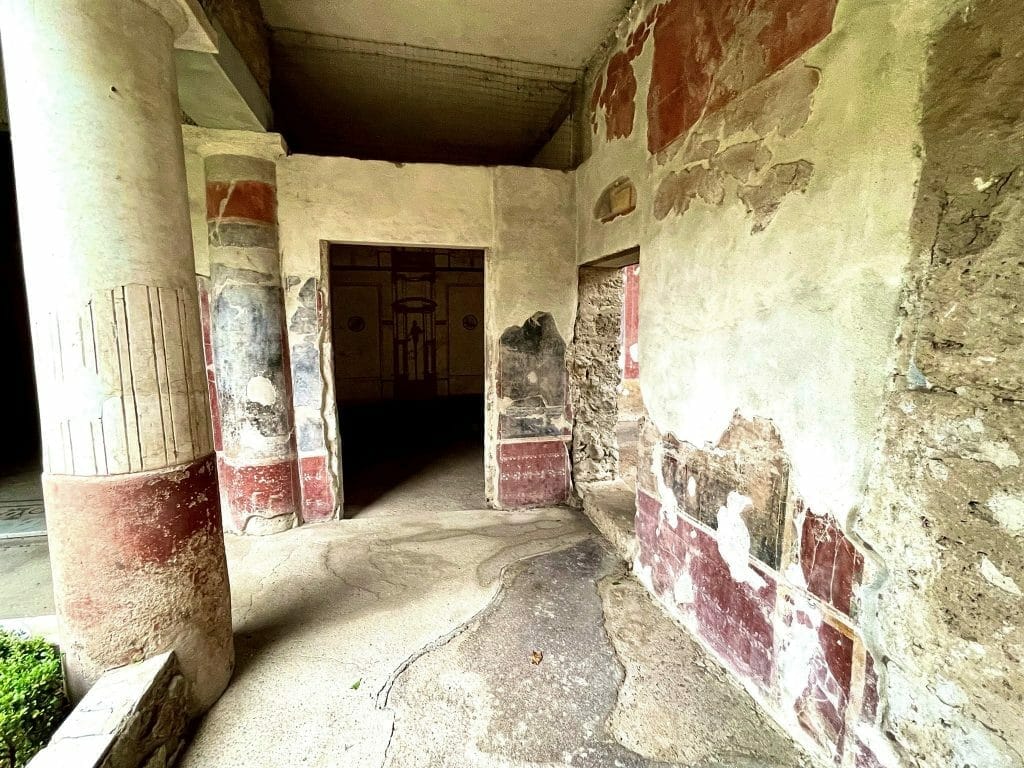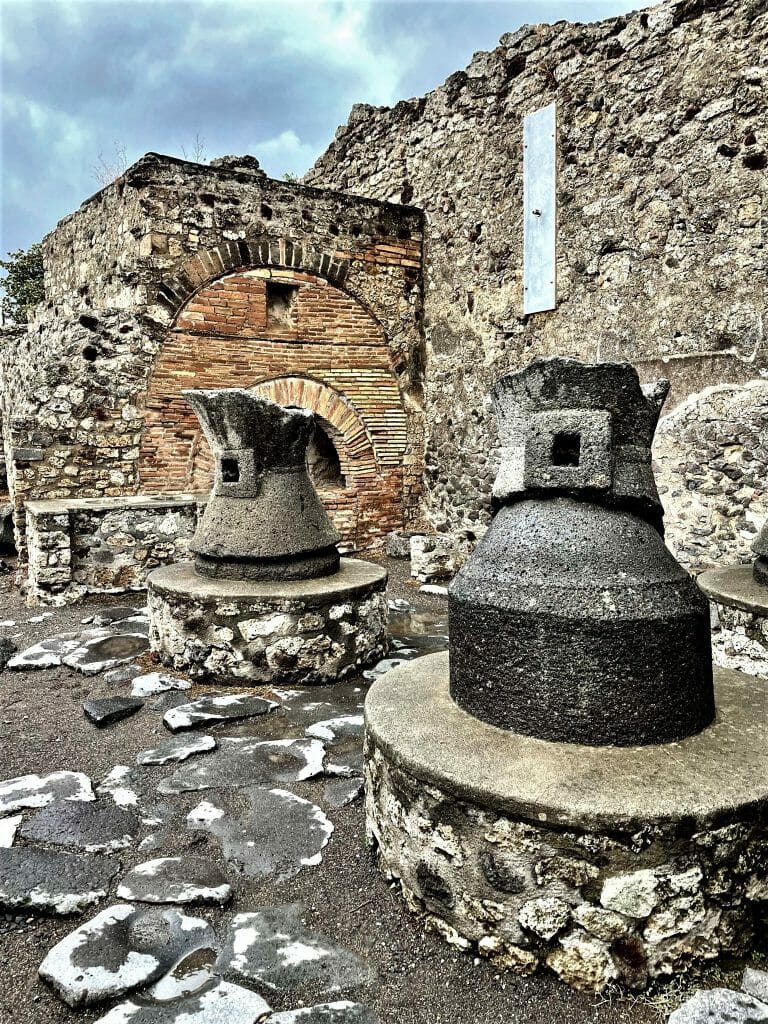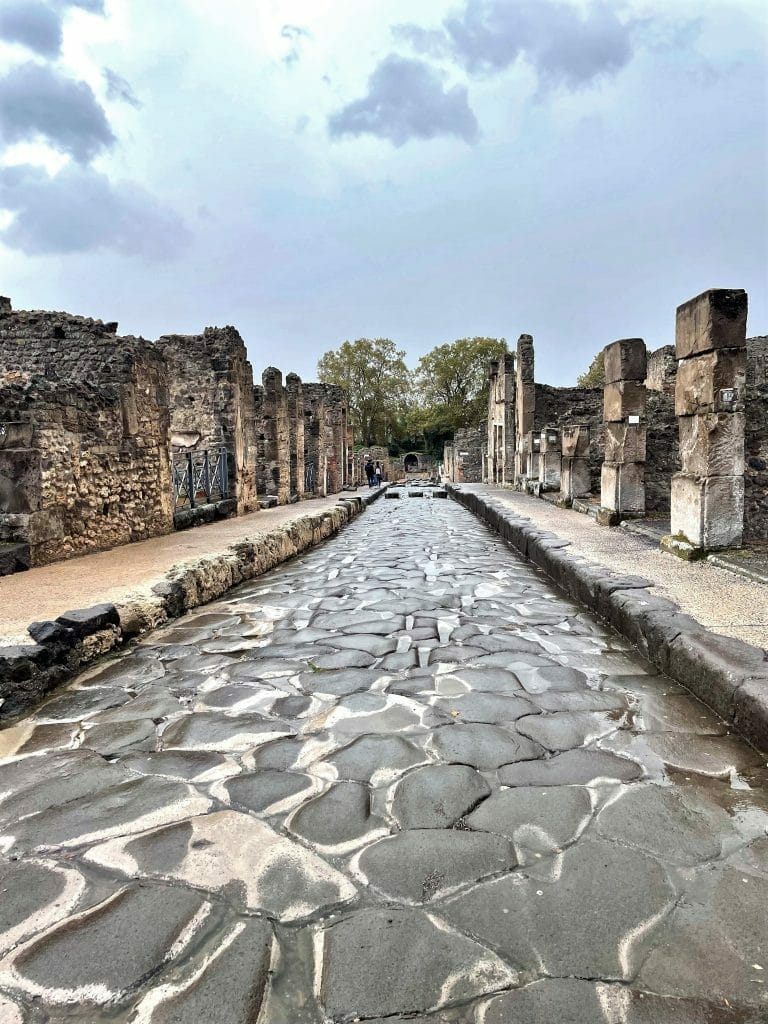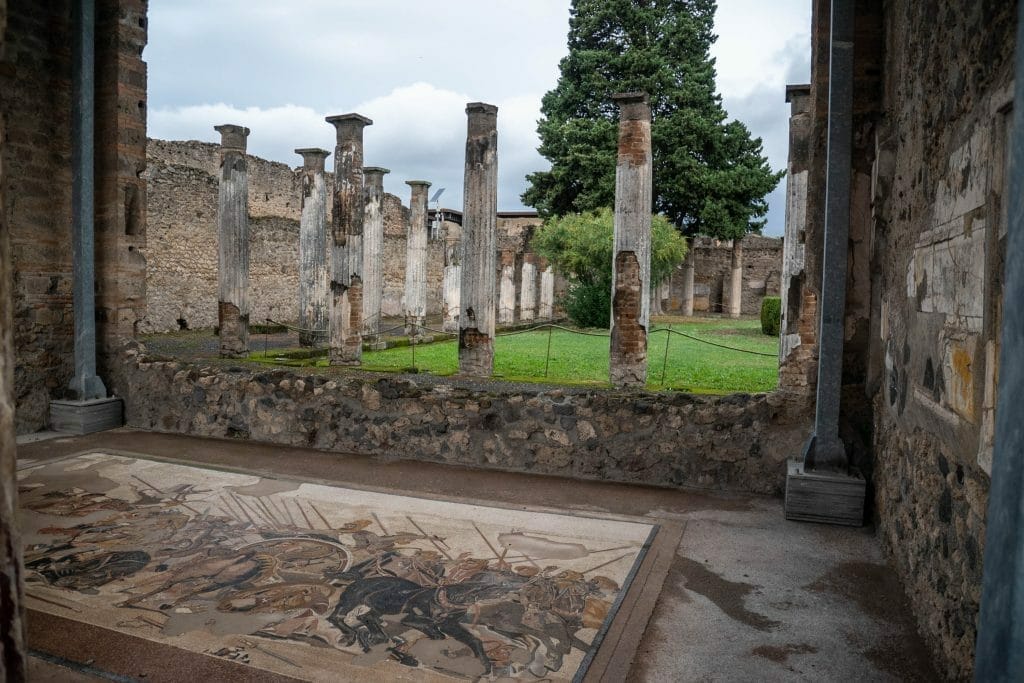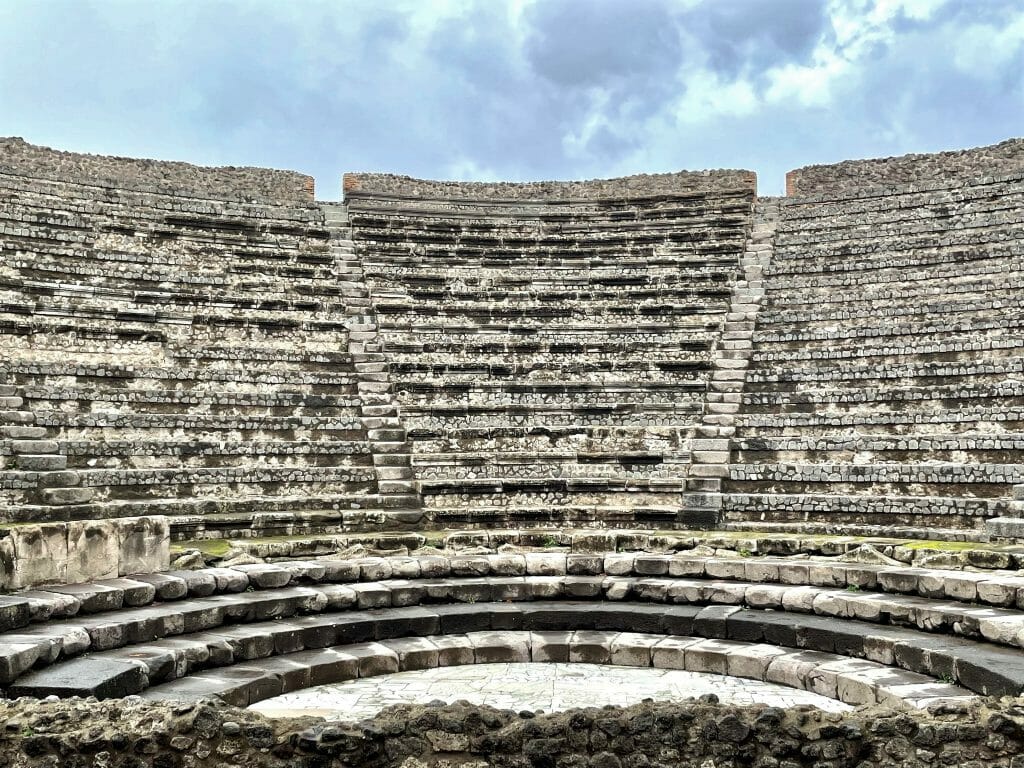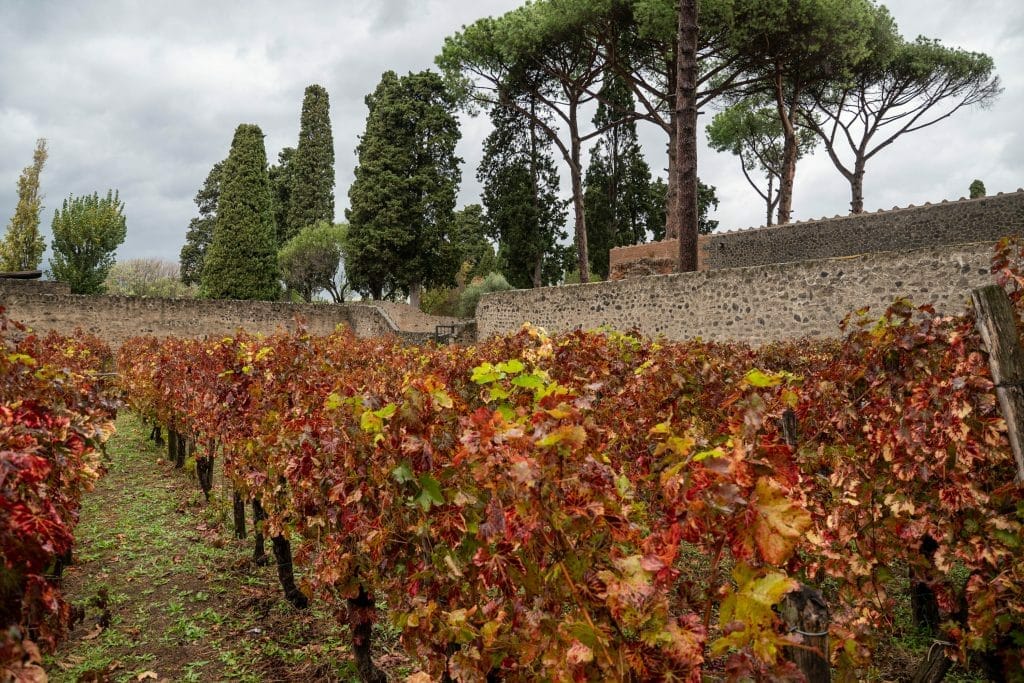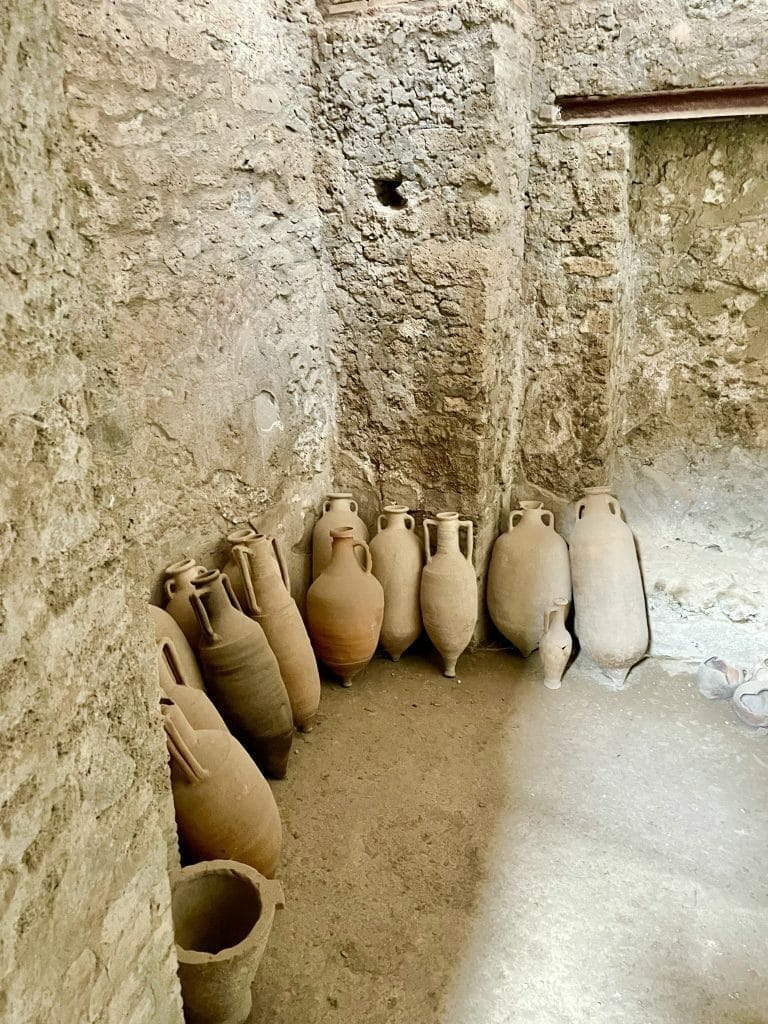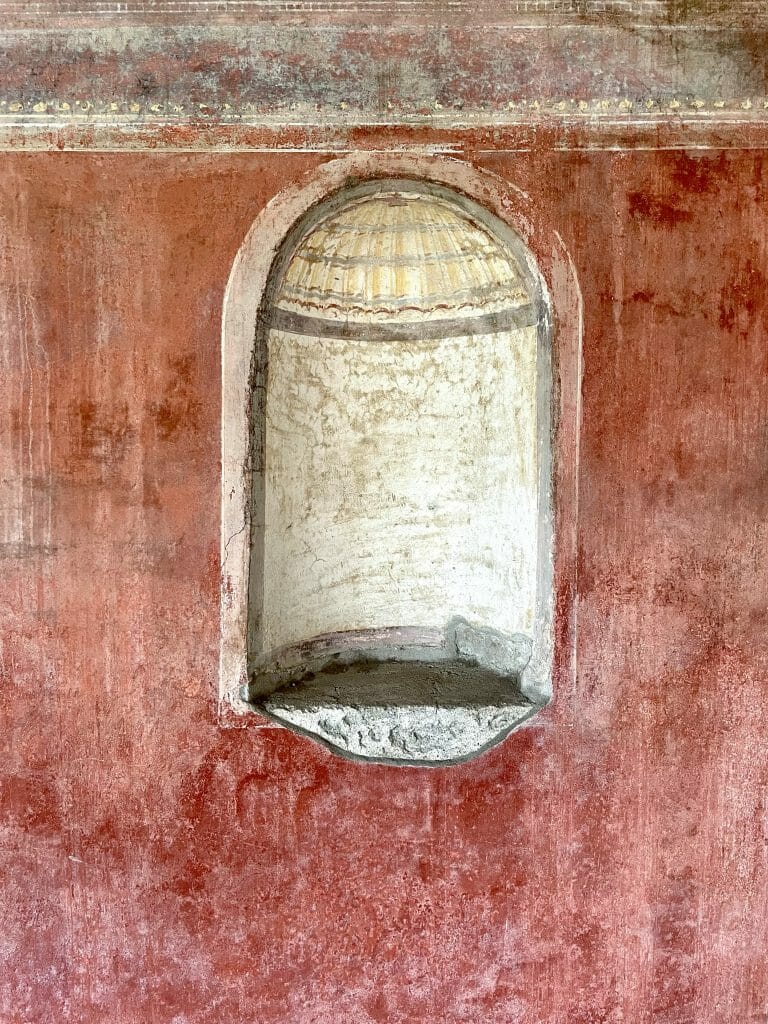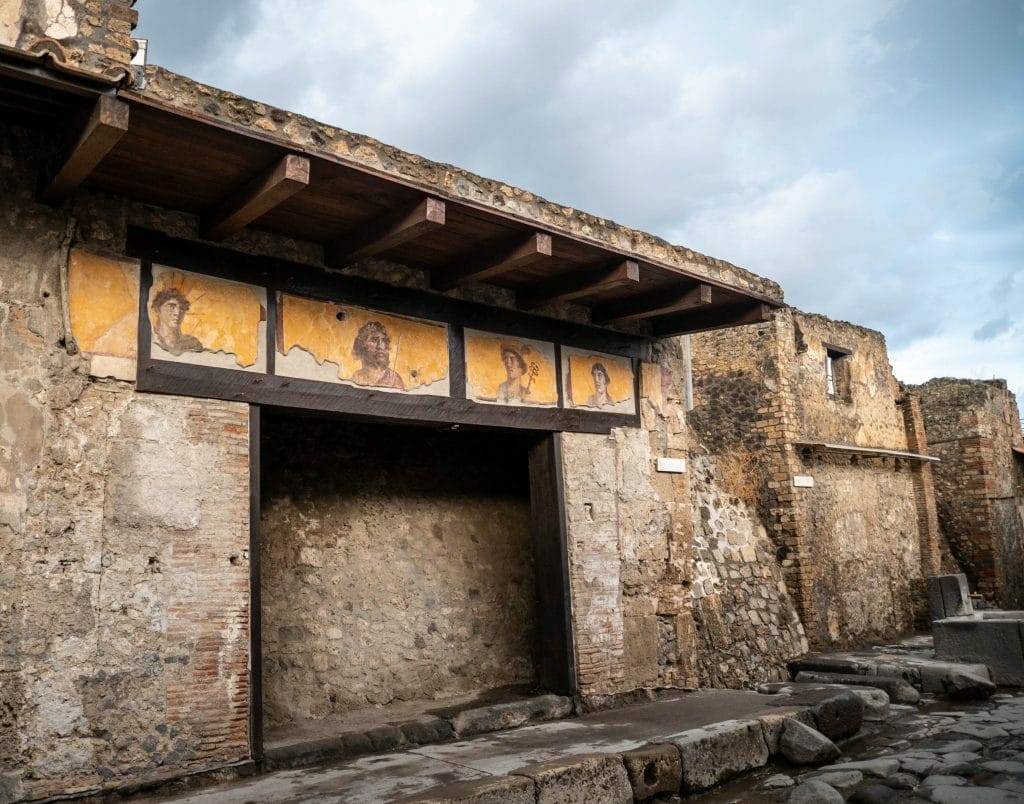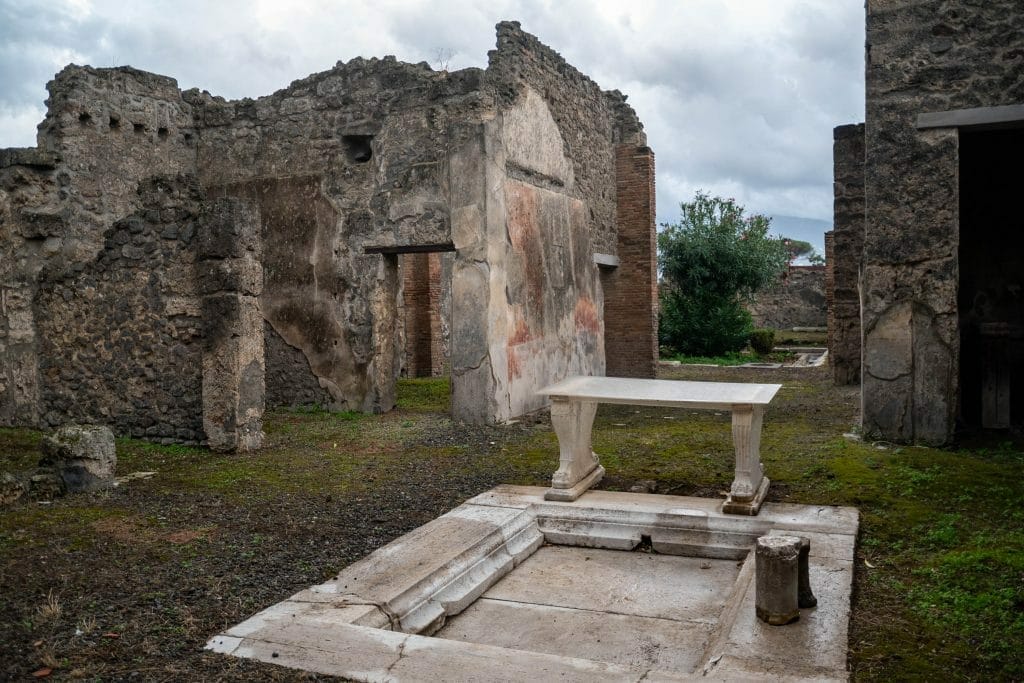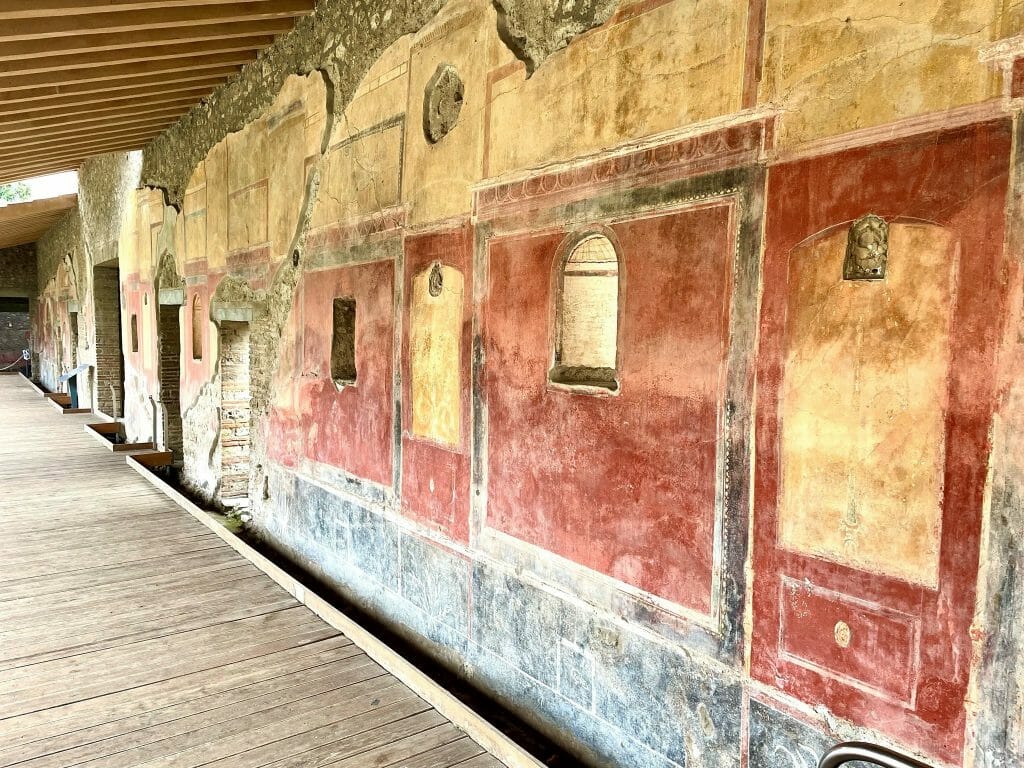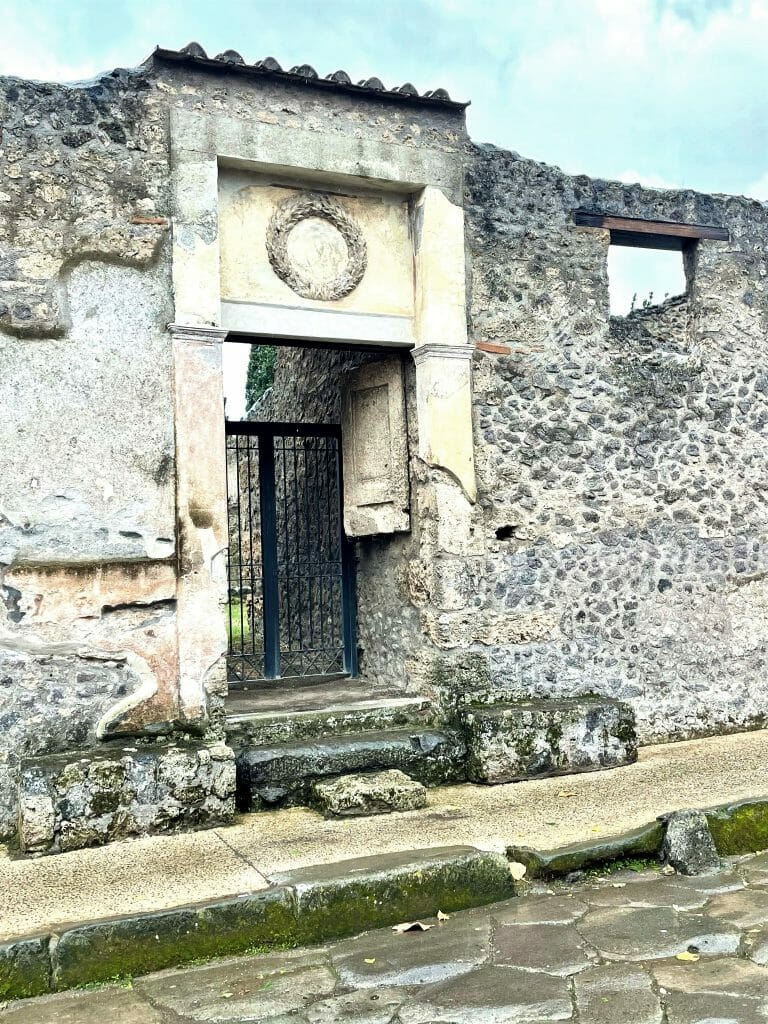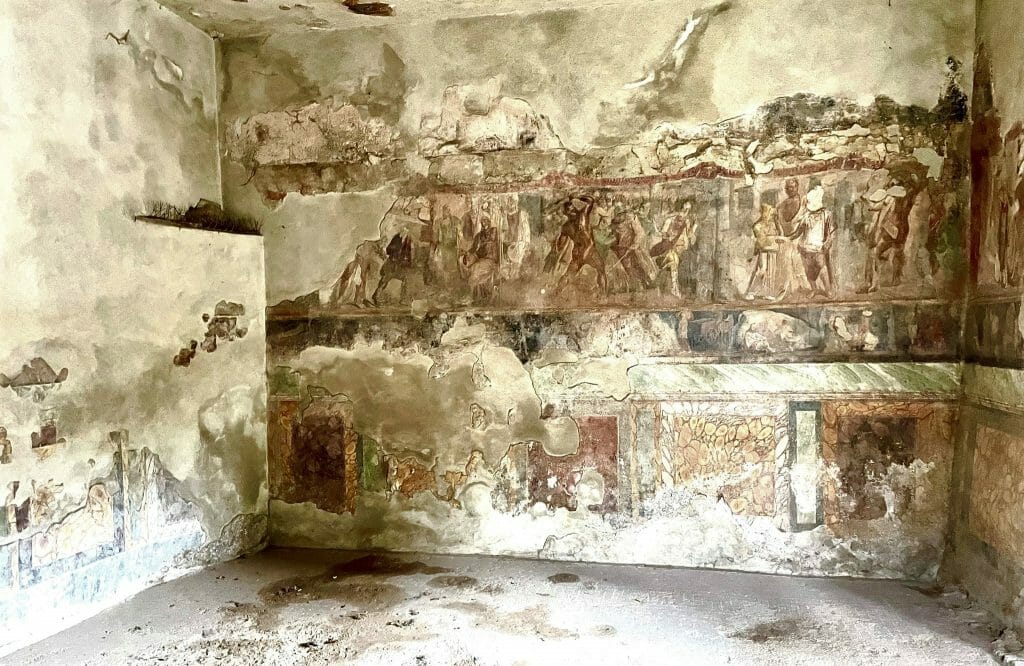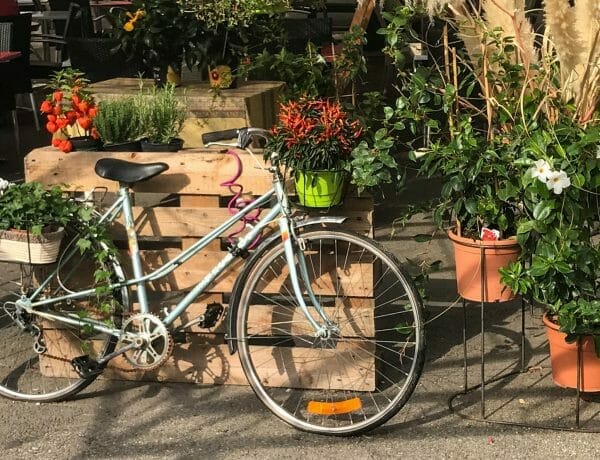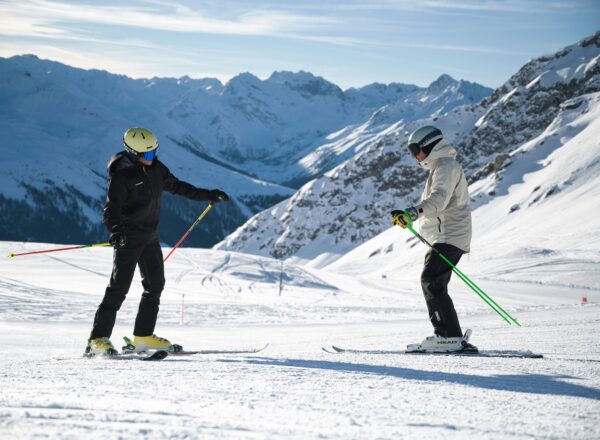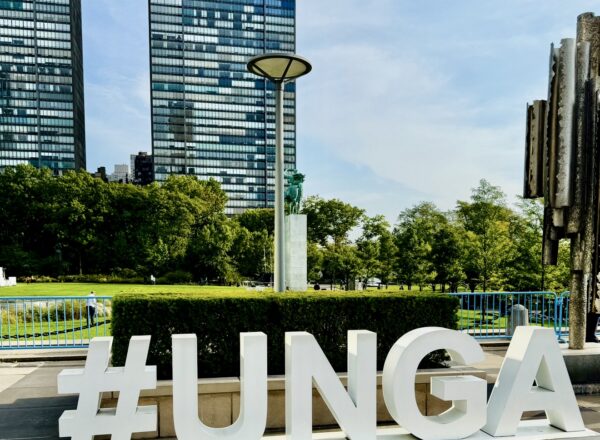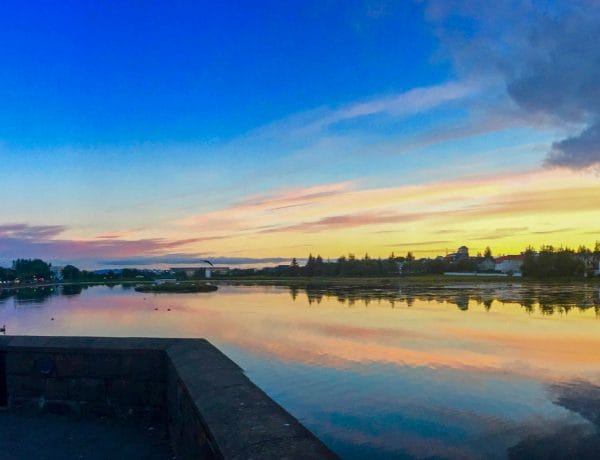“When you walk through Pompeii, it feels like you’re walking through history itself. The streets, the houses, the shops, the amphitheater—all have their stories to tell”
- Pompeii Realized
- The Pompeii discovery
- What We Have Learned
- The Impact of Their Story
- Our Visit
- Protecting and Keeping Pompeii for Future Generations
- How Can You Do Your Part?
- How Much Time Should You Give to See Pompeii?
- How to Get to Pompeii
- There are Three Pompeii Entrances
- Valuable Tips for Your Visit to Pompeii
- Ticket Tips
- When To Go
- Where to Stay
- Facilities At Pompeii
- Is Pompeii handicap Accessible?
- Other Ancient City Sites
- Visiting Mount Vesuvius
- Do Your Homework
- Final Thoughts
- Our Pompeii Photo Gallery
- Our Top Recommended Travel Products
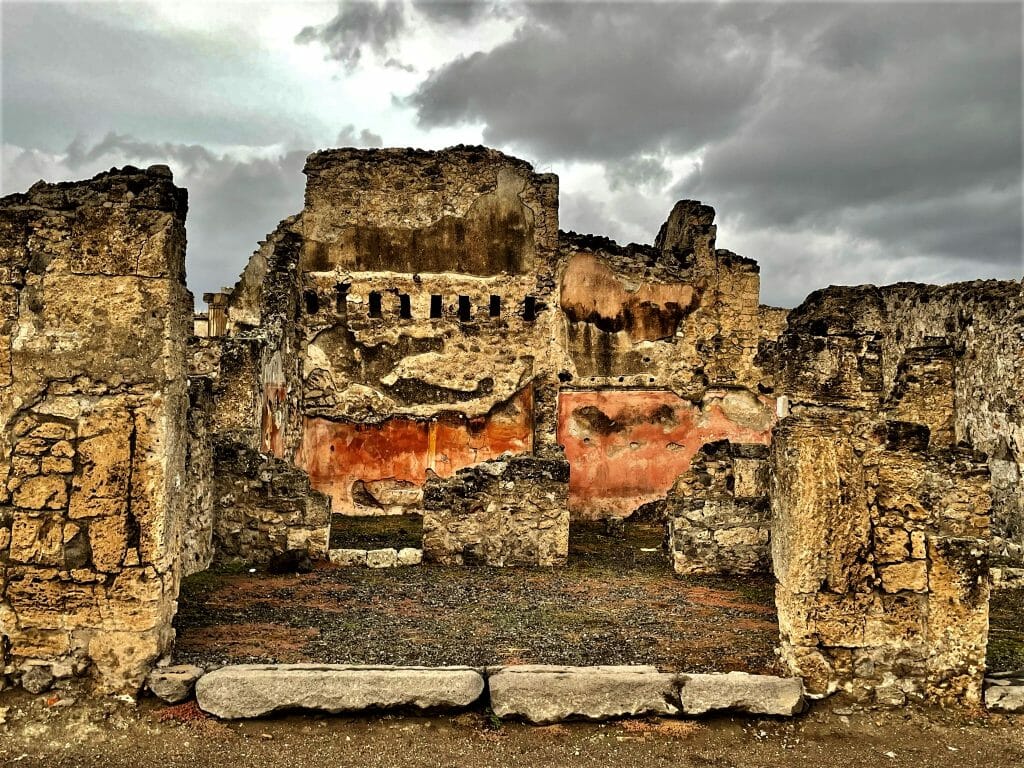
Since childhood, the story of Pompeii, equal parts fascinating and tragic, has captured our imagination. PBS specials and Rick Steves episodes had planted the idea firmly in our minds, but seeing it in person always felt like a distant dream. Pompeii was a grand Roman city frozen in time; how could we not long to walk its streets? As children, we never imagined we’d actually stand where ancient Romans once lived, worked, and thrived. Yet there we were, in the heart of Pompeii, living that dream.
The forecast promised torrential rain, as if daring us to turn back. But with tickets in hand and anticipation running high, nothing was going to keep us from this archaeological wonder.
From the moment we entered, amazement never left us. We wandered through homes, streets, and public spaces that still whispered echoes of daily life nearly two thousand years ago. Except for a few brief showers, the rain spared us, leaving the air cool and the crowds thinner. It was almost perfect. Time slipped away too quickly, and we left wishing for just a little more. For those hours, though, it felt as though we had been transported back to a thriving Roman city, invited into the lives of its people.
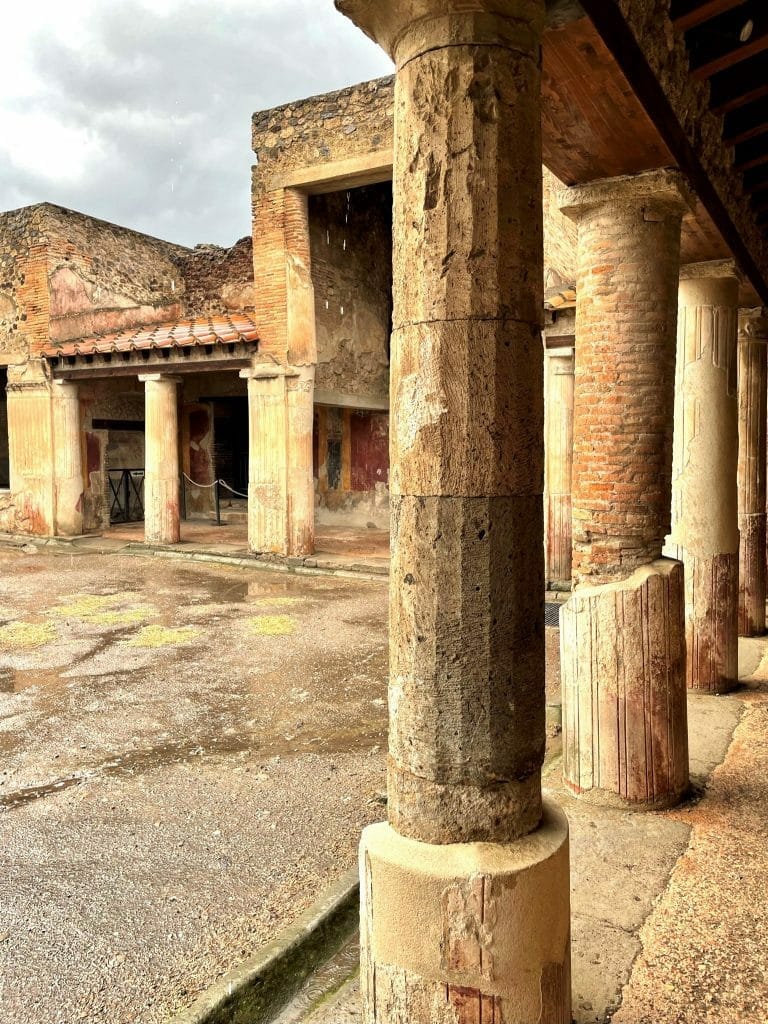
Pompeii Realized
Pompeii, one of the world’s most famous archaeological sites, lies just 30 minutes south of Naples and 40 minutes north of Sorrento in southern Italy’s Campania region. The city rests on the southeastern flank of Mount Vesuvius, whose looming presence defined both its prosperity and its destruction. Once a thriving Roman settlement known for its villas, temples, and bustling streets, Pompeii met a sudden and tragic end on August 24, 79 AD, when Vesuvius erupted with catastrophic force. Within hours, thick layers of ash and pumice swallowed the city, while a surge of searing gases and molten rock the following day sealed its fate. Homes, treasures, and lives were frozen in time beneath several meters of volcanic debris.
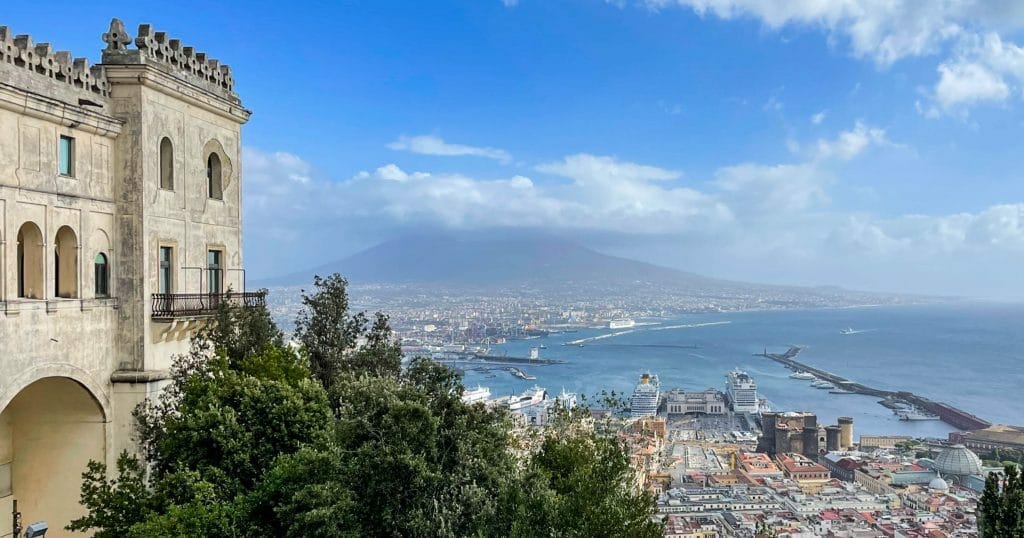
The city was still reeling from a powerful earthquake that struck 17 years earlier when Mount Vesuvius delivered its final, devastating blow. At the time of the eruption, Pompeii’s population numbered around 22,000, and it is believed that roughly 2,000 lives were lost within its walls on that fateful day.
For the next 16 centuries, Pompeii seemed to vanish from memory. With little written record of its existence or of the eruption that buried it, the once-thriving Roman city faded into obscurity. Just beneath the surface, however, it lay perfectly preserved, sealed in ash and pumice, waiting to be rediscovered and to reveal its story to the world.
Today, Pompeii stands as a UNESCO World Heritage Site, recognized alongside the neighboring towns of Herculaneum and Torre Annunziata, which also suffered from the eruption. The archaeological park is encircled by the modern city of Pompei, home to more than 25,000 residents, a striking reminder of how past and present now coexist in the shadow of Vesuvius.
The Pompeii discovery

In 1592, while constructing an underground aqueduct, architect Domenico Fontana stumbled upon the ruins of Pompeii. He tunneled through sections of the ancient city and its buildings but kept his discovery quiet, leaving it hidden once again beneath the earth.
The nearby city of Herculaneum resurfaced in 1709, and systematic excavations began in 1738 under the Bourbon kings of Naples. A decade later, in 1748, work finally started at Pompeii itself. What followed marked the dawn of modern archaeology. For the first time, scholars recognized the immense cultural and scientific value of such a discovery, and experts were brought in to excavate and study the site carefully.
What they uncovered was astonishing: a sophisticated Greco-Roman city frozen in time. Grand public buildings, elegant squares, bustling markets, and a vast amphitheater emerged from the ash, alongside villas adorned with frescoes and mosaics. Entire bakeries were found with loaves still in their ovens, shops with their goods intact, and tragically, the haunting remains of residents caught as they tried to flee. Pompeii offered an unparalleled glimpse into daily life in the 1st century, its rediscovery forever changing how we understand the ancient world.
Visiting Tuscany soon? Check out our Castello Monteriggioni, Tuscany: A Visitor Guide
What We Have Learned


The knowledge gained from Pompeii’s excavations continues to offer extraordinary insights into the ancient world. The blanket of ash and pumice sealed the city so completely that oxygen could not penetrate, leaving frescoes, mosaics, inscriptions, and even household items astonishingly intact. These layers preserved not just structures, but also the rhythms of everyday Roman life.
Those who lost their lives also “rose from the ashes.” As excavators uncovered skeletons, they noticed hollow voids in the volcanic layers, spaces once filled by human and animal bodies that had long since decayed. In the 1860s, archaeologist Giuseppe Fiorelli pioneered a groundbreaking method: pouring plaster of Paris into the voids. When the surrounding ash was carefully removed, what emerged were lifelike casts of Pompeii’s residents in their final moments.
The results were haunting. Mothers clutching children, a terrified four-year-old, couples locked in an embrace, individuals writhing in pain, and groups huddled together, all frozen in time and emotion. Even animals, from loyal dogs curled up in agony to horses still harnessed, were preserved in plaster. Each cast told a silent but devastating story of the human tragedy that unfolded in August of 79 AD.
Ongoing Discoveries
In recent years, advanced imaging, such as CT scans, has deepened our understanding. These scans allow researchers to determine the age, sex, diet, and even health conditions of Pompeii’s residents. Radiologists have spoken of feeling emotionally affected by the process, describing a connection to the casts as though they were treating patients rather than studying archaeological remains.
Where records are silent, however, mystery remains. Scholars still debate the exact number of people who died, the percentage of the city’s population that escaped, and the full timeline of the eruption’s phases. Despite centuries of study, Pompeii continues to guard some of its secrets, even as it reveals new layers of human history.
The Impact of Their Story
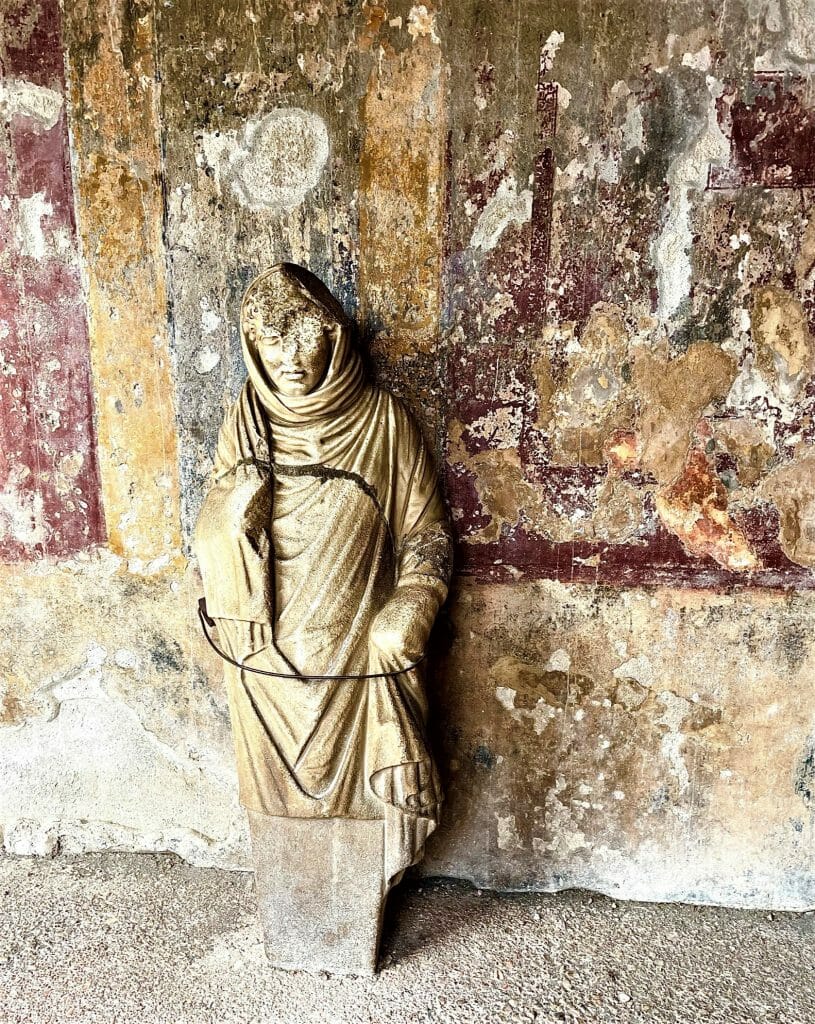
Viewing these casts in person is every bit as powerful as you might imagine. The terror and hopelessness of that day are etched into their postures, faces contorted, arms raised, bodies curled in futile attempts to shield themselves. It is remarkable and heartbreaking all at once. Their stories, though silent, feel deeply personal, pulling you into the human side of this tragedy.
Despite all the research we had done before our visit, nothing could prepare us for the reality of walking Pompeii’s streets. It is an experience unlike any other. To tread the same stone-paved roads that the Romans did nearly two thousand years ago is to step into another world. The sidewalks still hold raised stepping stones, clever solutions that allowed pedestrians to cross during rain while carts rolled through the channels below.
Inside the city, the scale of life becomes tangible. Lavish villas, decorated with intricate frescoes and mosaics, stand beside modest homes, each reflecting a distinct slice of society. The markets must once have bustled with goods and voices, offering everything from fresh produce to fine wares. Elegant public bathhouses reveal the Romans’ sophistication. At the same time, the infamous brothel, its walls adorned with frescoes that doubled as a “menu,” is a striking reminder that Pompeii preserved every facet of daily life, from the refined to the raw.
Our Visit
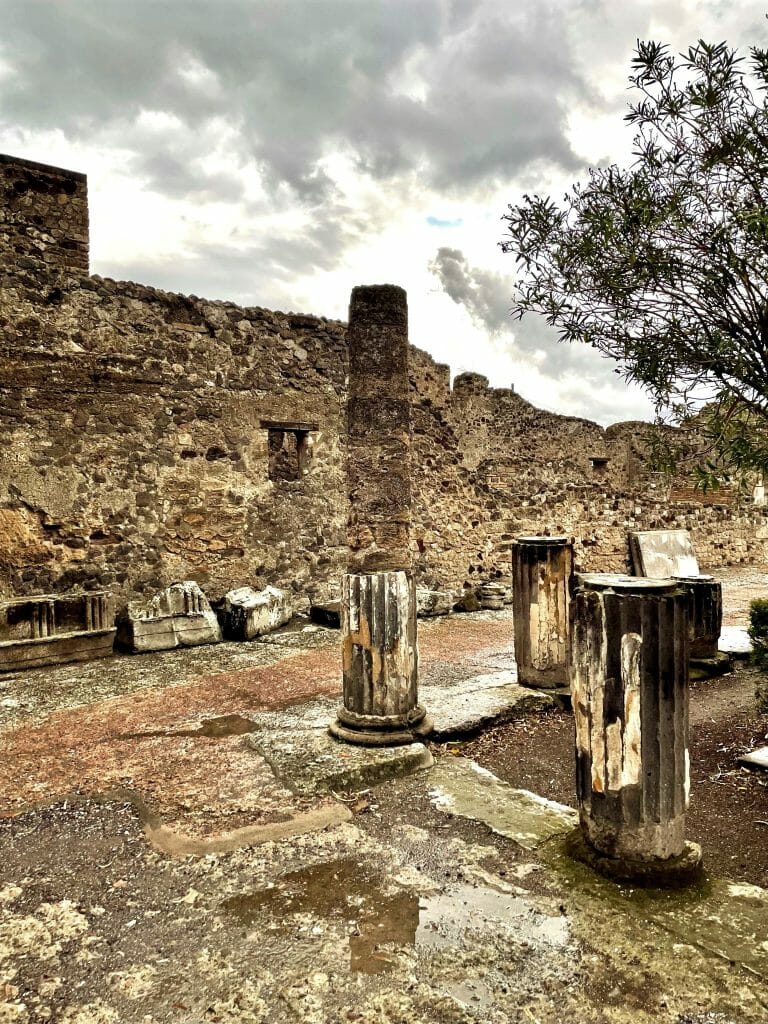
We visited Pompeii in the off-season, with rain threatening all day. The silver lining? We had much of the city nearly to ourselves, as you’ll notice in our photos. Walking down those long, deserted streets felt like a rare gift, giving us the chance to pause, study, and photograph this remarkable place in detail. Without the distraction of crowds, it became easier to imagine Pompeii as it once was, a bustling Roman city alive with noise, commerce, and conversation.
The scale of the site is staggering. Pompeii spans roughly 163 acres, and only about two-thirds have been excavated. Entire neighborhoods still lie buried, holding untold stories of the ancient world. Even with a full day of exploration, we felt there was much more to see, and it’s easy to spend two days wandering if you want to take it all in.
What struck us most was how exceptionally well-preserved and respectfully maintained the site is. From the moment you step inside, it’s clear that Pompeii is treated with the reverence it deserves. Unlike many tourist attractions, there are no souvenir stalls, street vendors, or restaurants cluttering the ruins. Aside from one modest cafeteria tucked within the vast expanse, the focus remains entirely on the ruins themselves. The result is an experience that feels immersive, unspoiled, and true to the spirit of discovery.
Buy tickets from Pompeii’s Official Ticket Site.
The entry price is 22 euros for those aged 25 and above. They do limit daily entry, so purchase in advance.
Protecting and Keeping Pompeii for Future Generations
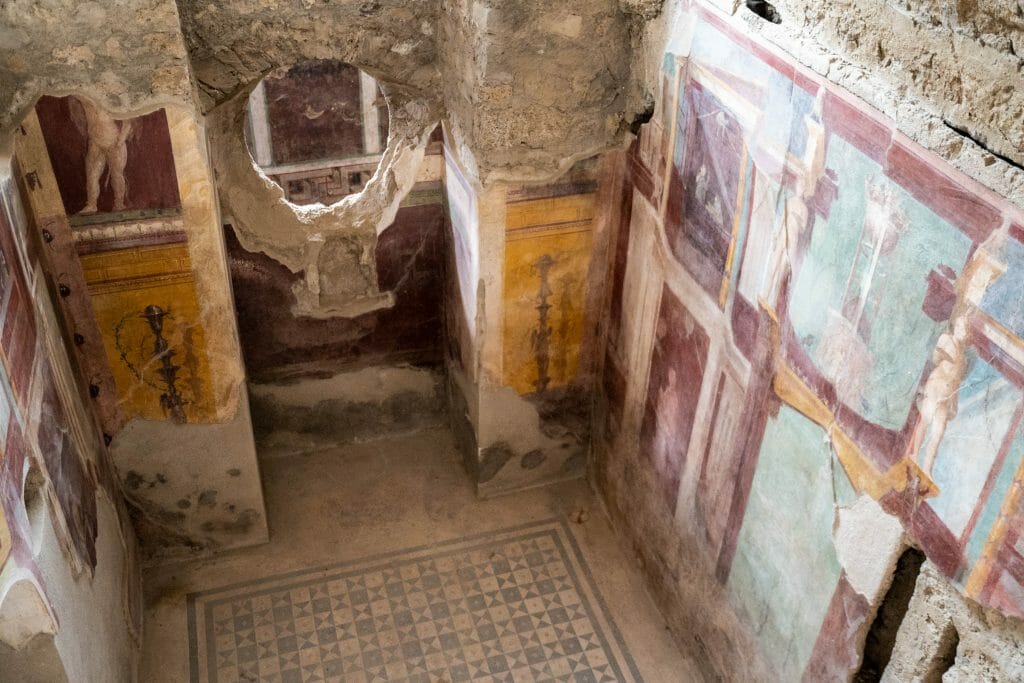
Pompeii welcomes millions of visitors each year, making it a powerful reminder of why sustainable tourism matters. The sheer volume of foot traffic places enormous pressure on its ancient streets and fragile ruins.
Not long ago, the site’s very survival came into question. Years of neglect, insufficient funding, and the strain of mass tourism led to crumbling walls and collapsed structures, prompting the Italian government to declare a state of emergency. In response, large-scale restoration projects, stricter preservation measures, and international support, including from UNESCO and the European Union, helped stabilize and protect the ruins.
Today, significant efforts continue to strike a delicate balance between accessibility and conservation. From limiting visitor numbers in sensitive areas to implementing new preservation technologies, Pompeii stands as both a wonder of the ancient world and a case study in how cultural treasures must be safeguarded for future generations.
How Can You Do Your Part?
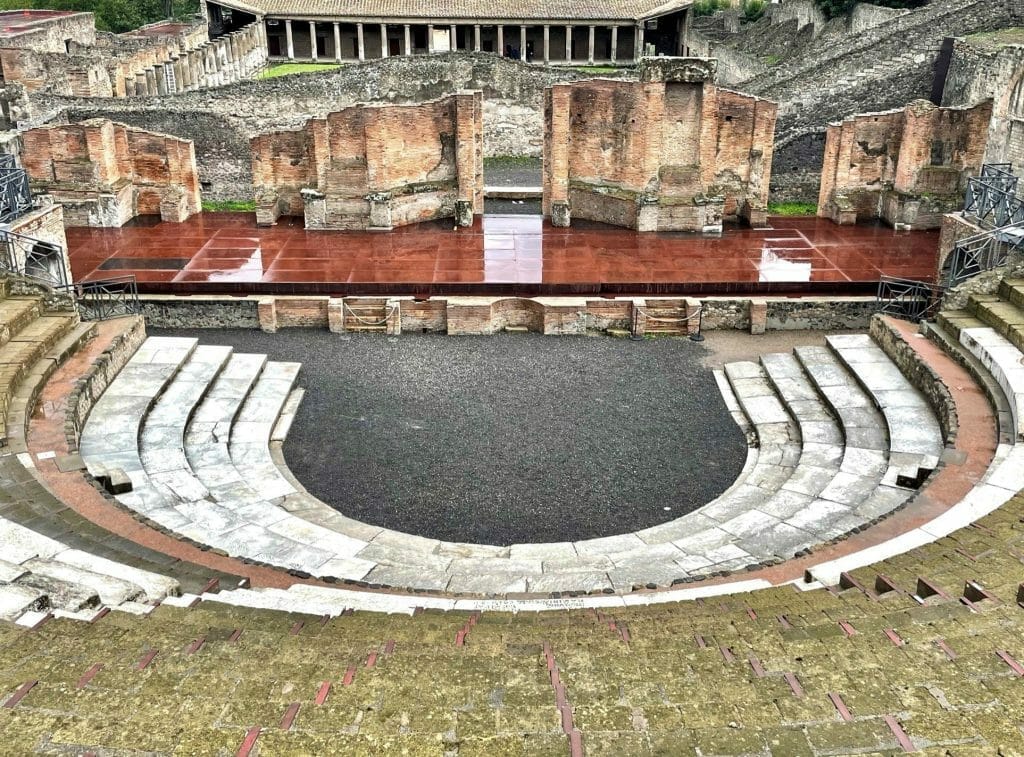
Visit Pompeii during the off-season if you can, and always remain within established areas and designated paths. Avoid leaning on ancient walls for photos or rest, and never climb on the ruins or touch the displays. If an area is roped off, resist the temptation to slip inside for that “perfect shot.” Instead, ask staff if access is possible.
Please treat the site with the respect it deserves. Carry out all trash, and never remove anything from the ruins, no matter how small. Shockingly, some visitors still pick off mosaic tiles or pocket tiny “souvenirs.” Such actions not only damage irreplaceable history but also risk prompting management to restrict access to fragile spaces.
Pompeii has endured nearly two thousand years under ash and pumice. Let’s do our part to ensure it remains intact for generations to come.
How Much Time Should You Give to See Pompeii?
Visiting Pompeii can be an immersive and fascinating experience, and the amount of time needed to explore the ancient city largely depends on your interest in history and archaeology. A typical visit can last anywhere from 4 to 6 hours, allowing you to cover the main highlights, such as the Forum, the Villa of the Mysteries, and the House of the Faun. However, if you’re truly captivated by the site, like many visitors, you may find yourself wanting to linger longer, as there is so much to discover in the well-preserved ruins.
With no crowds, our visit took 7 hours, which gave us the freedom to explore at our own pace, pause to admire the detailed frescoes, mosaics, and intricate street layouts that tell the story of this once-thriving Roman city. It’s important to note that the size of the crowds can have a significant impact on how long your visit takes. On busier days, navigating through the ruins may take longer, as the more popular sites can get crowded, particularly in high tourist seasons. If you’re looking to make the most of your experience, consider going early in the morning or later in the afternoon to avoid the larger crowds.
How to Get to Pompeii
The easiest way to reach Pompeii from either Naples or Sorrento is on the Circumvesuviana local train. The stop you’ll want is Pompei Scavi Villa dei Misteri, located directly on the line between Naples and Sorrento. From there, it’s less than a five-minute walk to the Porta Marina main entrance of the ruins.
An excellent alternative is the Campania Express, a tourist-focused train that runs on the same route but makes fewer stops. It connects only the most popular sites, Naples, Pompeii, Herculaneum, and Sorrento, and offers comforts like air conditioning, guaranteed seating, and luggage space. Tickets cost more than the Circumvesuviana, but the extra convenience often makes it worthwhile, especially during peak season.
While the trains are generally safe and reliable, the Circumvesuviana can be crowded at peak hours, making it a target for pickpockets. Keep bags close, wallets secure, and stay alert. With a bit of awareness, most travelers find the journey smooth and stress-free.
Go to the source for the most current info: Pompeii Official Site
There are Three Pompeii Entrances
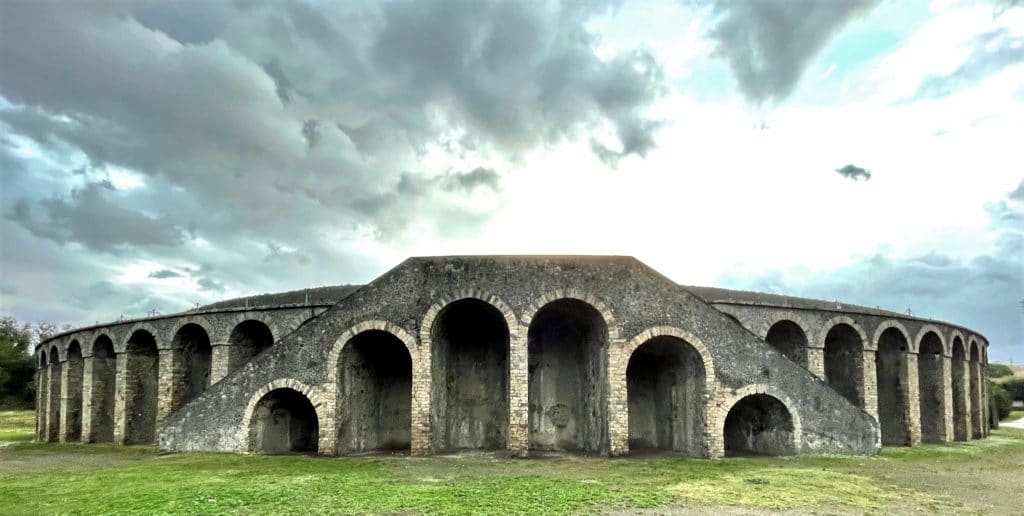
Porta Marina is the main entrance to Pompeii, located directly across the road from the Pompeii Scavi train station. This entrance is the most popular among tourists due to the numerous facilities available. You can access the information kiosk, hire audio guides, and shop for souvenirs here. Express access to Pompeii is open at this entrance. Since the other gates do not have all the above services, they are the most crowded of the three gates, and you can expect longer wait times.
Piazza Esedra has a bookshop and restrooms. Although not very far from the Porta Marina entrance, the Piazza Esedra entrance is less crowded and is where group tours meet. It is the least serviceable of the three entries, but access is more manageable at this gate. Please note that this entrance does not offer facilities such as audio guide rentals or baggage checks.
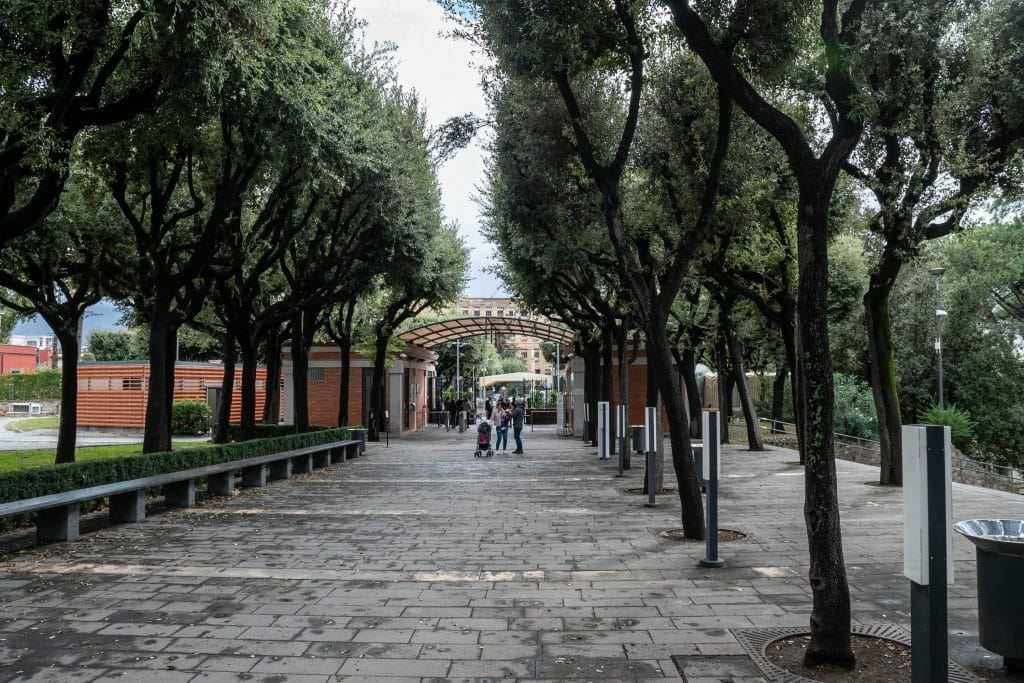
Porta Antiteatro is located east of Pompeii, a 15-minute walk from Porta Marina. The Piazza Anfiteatro entrance is considered the best for sightseeing, as it leads directly to the amphitheater, Forum, and other essential sites in Pompeii. You can rent an audio guide at this entrance and store your luggage for free. There is an ATM, a bookshop, toilets, and luggage lockers here.
Valuable Tips for Your Visit to Pompeii
- Get a map!! Free maps are available at the entrances.
- Plan your approach and which sites are your must-dos.
- Wear good shoes.
- Wear sunscreen even on cloudy days. There is little shade in Pompeii.
- Seeing all three sites and the Volcano would be super rushed. You would barely see what is there at the sites. To see everything, plan for at least two days.
- Bring snacks. There is only a tiny cafeteria in the whole complex. During the COVID-19 pandemic, you were not allowed to eat inside the building.
- Villa dei Misteri is magnificent, but a bit away from central Pompeii city. Check first to see if it is open. It is a long walk to the Villa. We walked there to find out it was closed, which cost us and others a good 30 minutes of our day.
- Bring water, as there is only one small cafeteria in the complex where beverages can be purchased. There are water sources in the park where you can fill your bottle.
- Pompeii is a blast to photograph, so be sure to bring a fully charged battery or a backup battery pack for your cell phone and camera.
- Avoid the guides who approach you outside the gates. If you wish to use a guide, only use official ones.
- Bring only a small bag into the ruins. It is a long day and could weigh you down after a while. More oversized items may be prohibited, especially during periods of high crowd density. Luggage lockers are available at the Porta Antiteatro entrance.
- Do your research before you go.
Ticket Tips
- Ignore ticket offices other than those at the gates or the official online ticket office for Pompeii. The ticket cost at the time of this article was 16 euros.
- If you plan to travel during peak season, it is advisable to purchase your tickets online. Lines are known to be very long, and they do limit admittance. Once they reach the max allowed, that is it!
- You can buy tickets at the official Pompeii ticket site by clicking Ticketone. Prices are 23 euros for guests 25 and older.
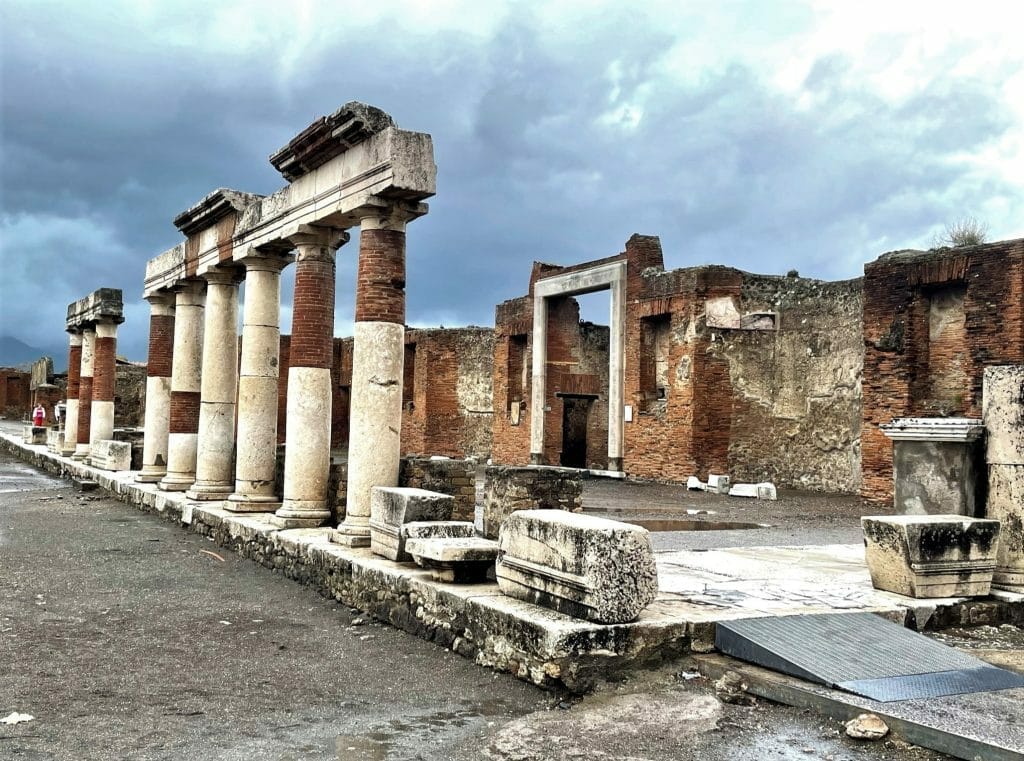
When To Go
Weather plays a significant role in shaping your experience at Pompeii. In summer (June–August), the site can be scorching, with little shade and stone streets that radiate heat—temperatures often exceed 90–100°F (32–38°C). If you visit then, arrive early in the morning, wear a hat, and bring plenty of water. Spring (March–May) and fall (September–November) are ideal times to explore. Days are warm but not oppressive, the light is beautiful for photography, and walking the vast site is far more comfortable. These seasons also bring thinner crowds compared to mid-summer. Winter (December–February) tends to be mild and cool, with daytime highs ranging from 50°F to 60°F (10–16°C). Rain showers are common, but crowds are sparse, making it one of the most peaceful times to visit.
Regardless of the season, lines at the entrance can be long, and the park limits the number of daily visitors. To avoid delays and guarantee entry, always purchase your tickets in advance. Planning around the weather and booking ahead ensures you’ll spend more time exploring Pompeii’s ruins and less time waiting in line.
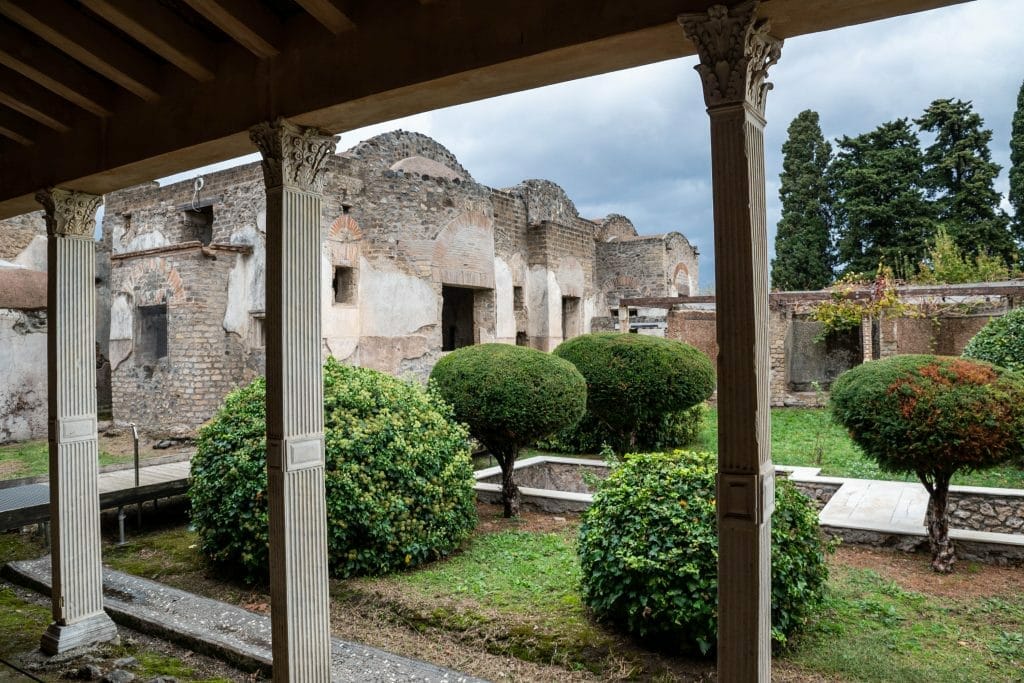
No time of the year should prevent you from visiting this fantastic site. In the summer, dress lightly, apply sunscreen, and bring water. In the winter, dress warmly and bring water. Pack an umbrella and poncho for the rain. We visited in the rain and were able to take shelter during downpours since there were few people at the site.
Where to Stay
When visiting Pompeii, there are endless choices, as it is centrally located to most major cities in the area. It is about 30 minutes south of Naples, 40 minutes north of Sorrento, and about an hour from Positano. We passed it heading from Naples, but visited it from our Sorrento location the next day.

Any hotel you stay in near or in these locations will quickly get you to Pompeii. We drove in and had no issue with parking. Here is a link to Booking.com, which will provide hotels available in the area.
When planning a trip, it’s always wise to compare accommodation prices across different platforms. Expedia, based in the U.S., and Booking.com, based in Europe, don’t always feature the same properties, so checking both can give you the best range of options. We personally prefer Booking.com for its user-friendly interface and wide selection, but we always recommend double-checking the hotel or vacation rental’s official website too, sometimes you’ll find exclusive deals or perks when booking directly.
Click the link below to explore hotels and vacation homes in the area you are planning to visit. Who knows? It might be just the spark you need to start planning your next grand adventure.
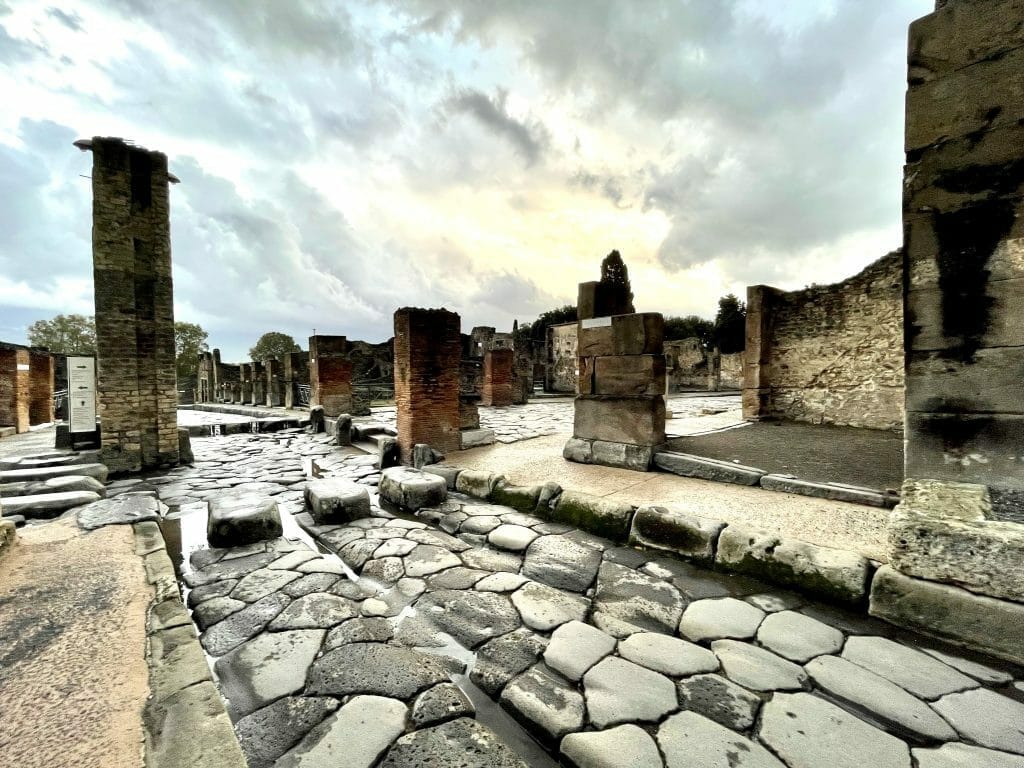
Facilities At Pompeii
Facilities at Pompeii are basic but sufficient for a site of its size. Restrooms and drinking water fountains are located throughout the archaeological park, and signage is clear enough to guide you to them without difficulty. Food options are limited to a single cafeteria inside the site, which provides simple meals and snacks. Eating is not permitted within the cafeteria itself, but there are outdoor areas nearby where you can take a break. To avoid long waits, especially during peak season, it’s wise to bring your own water bottle and some light snacks to enjoy outside the ruins.
Is Pompeii handicap Accessible?
Accessibility has improved in recent years, though navigating Pompeii can still be challenging. The site has introduced an “Accessible Route”, a designated path of about 3.5 kilometers designed to accommodate visitors with mobility challenges, including wheelchair users and families with strollers. This route connects key highlights such as the Forum, the amphitheater, and several houses. However, it’s important to note that many ancient streets are uneven, with high curbs and large stepping stones, which may still pose difficulties. For those needing extra assistance, guided tours tailored to reduced mobility are available and can make the experience much smoother.
Other Ancient City Sites
Visiting Herulaneim
Herculaneum, like Pompeii, was destroyed in the catastrophic eruption of Mount Vesuvius in 79 AD. Smaller and much quieter than Pompeii, it offers a more intimate and often more haunting experience. The site is remarkably well preserved, many of the buildings still have their upper stories intact, and colorful frescoes, mosaics, and even wooden furniture have survived thanks to the unique way the volcanic material sealed the town.
The tragedy of the eruption feels especially powerful here. Along the ancient shoreline, archaeologists uncovered boathouses filled with the skeletons of families who sought refuge, only to be overcome by the superheated gases and ash. These haunting remains serve as one of the most sobering reminders of the disaster.
Reaching Herculaneum is straightforward. It lies closer to Naples than Pompeii and can be accessed by car, bus, or the Circumvesuviana local train. From Naples, the journey takes about 20 minutes, and the train station Ercolano Scavi is just a short walk from the entrance to the archaeological site.
Visiting Torre Annunziata
The main attraction in Torre Annunziata is the Villa of Oplontis, a sprawling Roman seaside villa believed to have belonged to Poppaea Sabina, the second wife of Emperor Nero. Located about 3 kilometers from Pompeii, the Villa is a UNESCO World Heritage Site and offers a striking glimpse into the luxury and opulence of Roman aristocracy.
The Villa is renowned for its vivid frescoes, many of which are considered masterpieces of Roman wall painting. With its expansive gardens, colonnaded courtyards, and grand halls, Oplontis feels more like a palace than a home, showcasing the wealth and taste of the elite in the 1st century AD. Unlike Pompeii, which was a bustling city, Oplontis offers a more tranquil and focused experience, perfect for travelers interested in art, architecture, and the lifestyle of Rome’s upper class.
Reaching Oplontis is simple. It sits within the modern city of Torre Annunziata and can be accessed by car, bus, or the Circumvesuviana local train from Naples. The Torre Annunziata Oplonti station is just a short walk from the archaeological site.
Visiting Mount Vesuvius
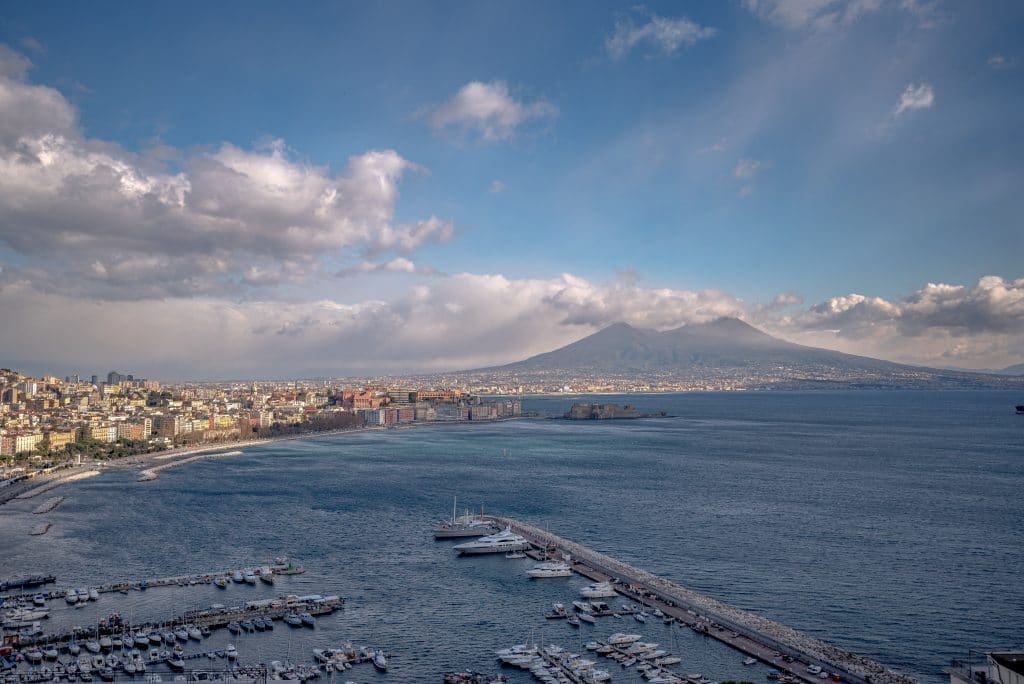
Mount Vesuvius, a still-active volcano, dominates the Bay of Naples with its imposing presence. From every angle, it is both breathtaking and unsettling, a reminder of the force that once buried Pompeii and Herculaneum beneath ash and pumice. The scars of the catastrophic 79 AD eruption remain etched into its profile, a constant testament to its destructive power.
As striking as Vesuvius is from a distance, nothing compares to experiencing it up close. Visitors can hike to the summit on a well-marked trail that winds through volcanic rock and scrub vegetation, culminating in views that stretch across the bay and deep into the massive crater. Standing at the rim is awe-inspiring; you can often see wisps of steam rising from vents, a humbling reminder that the mountain is very much alive.
Guided tours are available from Naples, Pompeii, and Sorrento, or you can make the trip independently by car or shuttle bus to the trailhead. The hike is moderately challenging but short, typically taking 30–40 minutes each way. Sturdy shoes, a hat, and water are essential, especially in the heat of summer. For many, climbing Vesuvius is the perfect complement to visiting Pompeii, an opportunity to witness both the destroyer and the destroyed.
The Hike to Reach the Crater
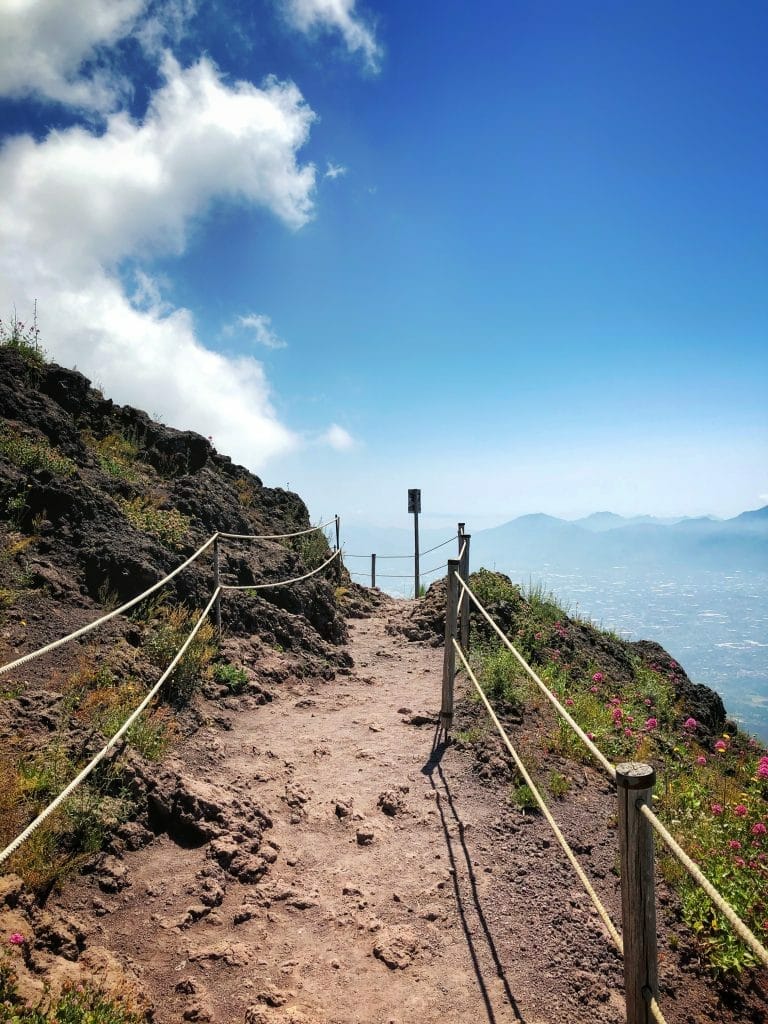
The hike to the crater of Mount Vesuvius takes about 90 minutes round-trip and rewards visitors with sweeping views of the Bay of Naples and the volcanic landscape below. Be sure to wear sturdy hiking shoes, bring plenty of water, and prepare for uneven terrain. Entry tickets can feel pricey, but most agree that standing at the rim of this still-active Volcano is a once-in-a-lifetime experience. Keep in mind that access is restricted during rainy days, when the trails and crater become unsafe.
Getting there requires some planning. From Pompei Scavi Circumvesuviana station, you can catch a bus to Vesuvius, but the most popular route is from Ercolano Scavi station. Directly outside the station sits the Vesuvius Express office, where you can purchase bus tickets to the mountain. Be prepared for long lines and crowded buses, especially during peak season. Return schedules can be unpredictable, and it’s not uncommon to hear stories of visitors stranded at the top and forced to pay steep prices for private transport back down. Keep a close eye on your return time to avoid unnecessary stress.
For those with rental cars, driving offers more flexibility. The road to the summit is steep, winding, and narrow, but manageable for experienced drivers. The main challenge is that parking spaces at the top are limited and fill quickly, especially in the late morning and early afternoon.
We did not take the tour ourselves, but feedback is mixed. Many cite frustration with wait times and logistics, while nearly everyone agrees the mountain itself leaves a lasting impression. The views from the rim and the chance to peer into the crater make the effort worthwhile.
Do Your Homework
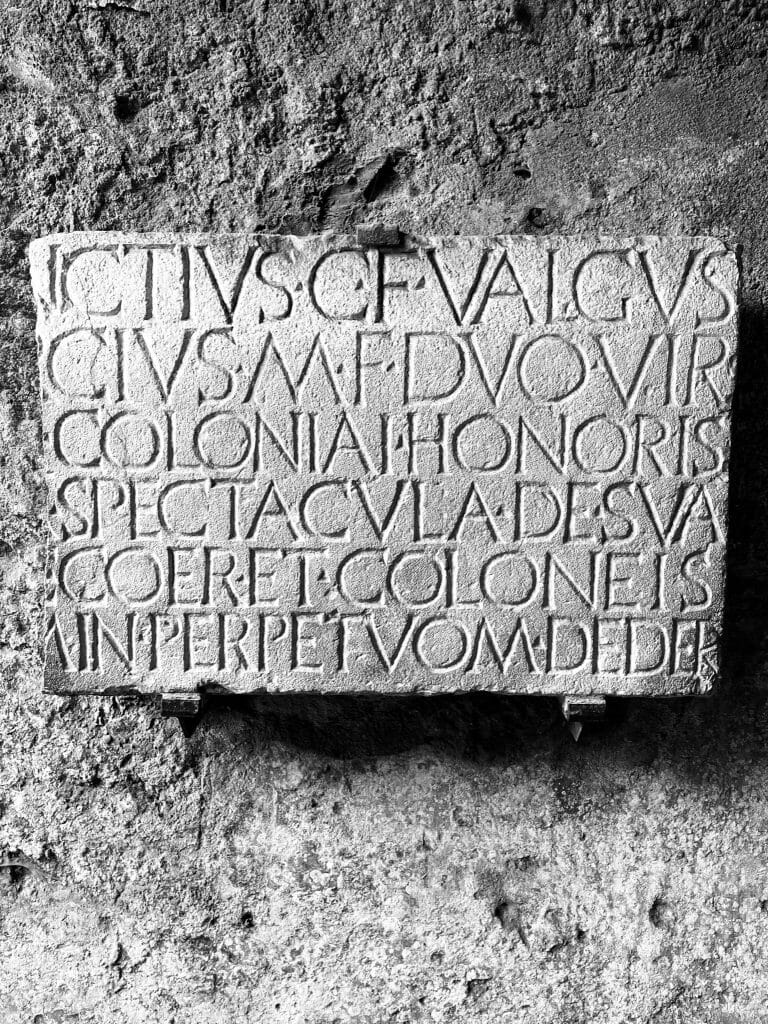
To truly appreciate your upcoming visit, we strongly recommend researching the history of Pompeii and the available sites. There are many ways to do this. Google Pompeii, but be prepared, as you will find many tour group sites that we suggest you avoid. Purchase a book online or borrow a book from the library. Watch documentaries or YouTube travel videos on Pompeii. Below is a list of suggested books and videos on Pompeii.
- Pompeii: A Captivating Guide to the City in Ancient Rome That Was Buried Because of the Eruption of Mount Vesuvius during the Rule of the Roman Empire
- Lonely Planet Naples, Pompeii & the Amalfi Coast (Travel Guide)
- Moon Amalfi Coast: With Capri, Naples & Pompeii (Travel Guide)
- Rick Steve’s video on Naples and Pompeii
- Sound Cloud Audio Europe Rick Steves Pompeii
- Rick Steves’ post on Pompeii
- Encyclopedia Britannica Pompeii page
- The Pompeii official site has some great info to prepare for your visit
Final Thoughts

The knowledge uncovered through Pompeii’s excavations continues to reshape our understanding of the ancient world. The city revealed levels of sophistication, from plumbing and urban planning to art and engineering, that Europe would not see again for centuries. The scale of scientific and cultural knowledge lost in the eruption is staggering, and the ruins serve as both a reminder of human ingenuity and of nature’s destructive power.
If you ever find yourself in this part of Italy, visiting Pompeii is an experience you cannot miss. To describe it in just a few words: magnificent, poignant, awe-inspiring. Walking its streets creates memories that linger long after you leave. Pompeii endures not only as a place of history but as a living voice of the past, preserved so future generations can learn from its tragedy. Listen closely, its story is there for all who are open to receiving it.
Pompeii endures, asking only that we remember.
© 2025 Wanderers Compass All Rights Reserved
Planning a trip to Italy? Check out our Italy Travel Guide, which is full of must-have information.
Our Pompeii Photo Gallery
















































Want to learn about Wanderers Compass?
Our Top Recommended Travel Products
Travel Insurance
Squaremouth.com
Our favorite travel insurance site!
We strongly advocate for comprehensive travel insurance, not only for minor inconveniences but also for major, unexpected events like medical emergencies. We never leave home without it. Our go-to resource is Squaremouth.com. which offers a user-friendly platform that connects you with top-rated, reputable insurance carriers. Plus, they’ll mediate on your behalf if you run into any issues.
To empower you as a consumer, we recommend you read our blog post on why travel insurance is essential and how to secure the best coverage from leading companies at an affordable price.
MedjetAssist
Medical transport back home from anywhere in the world
Medjet is a leading provider of global air medical transport. Unlike traditional travel insurance, which typically covers medical evacuation to the nearest facility, Medjet goes further by ensuring you’re transported back to the U.S. to the hospital of your choice once you’re stable enough to fly. Medjet offers membership plans that focus on medical transport, while Medjet Horizon provides expanded coverage for broader protection. Individual trip policies start at just $99, and annual policies are available for around $300. Most policies have an age limit of 74.
To learn more about how Medical Evacuation membership with Medjet Assist works, check out our blog post for a more detailed review.
Accommodations and Airfare
Booking.com
Hotels, Home rentals, BNBs, Flights, and other Transportation & Tours
Booking.com connects millions of travelers to unforgettable experiences, a wide range of transportation options, and incredible places to stay—from homes to hotels and beyond. As one of the world’s largest travel marketplaces, it supports well-known brands and entrepreneurs of all sizes. For its convenience, variety, and reliability, it’s our preferred booking platform.
Expedia and VRBO
Hotels, home rentals, BNBs, flights, and other transportation & tours
Expedia is a U.S.-based company with a mission to make global travel accessible to everyone, everywhere. At Wanderers Compass, we embrace independent travel, and platforms like Expedia are essential to making that a reality. Expedia allows you to book every aspect of your trip—from flights and accommodations to rental cars, cruises, and activities—making it a one-stop shop for all your travel needs.
Transportation
Daytrip
Personalized city-to-city private car transfer service
Daytrip provides an affordable private car service for city-to-city transfers worldwide, and we absolutely love their service. It’s a cost-effective alternative to renting a car, providing comfortable, stress-free travel with the bonus of scenic stops along the way. For example, we used Daytrip for travel between Budapest and Vienna, enjoying some fantastic detours to local attractions. With professional drivers and customizable routes, Daytrip ensures a smooth ride while allowing you to explore hidden gems and unique sights along your journey.
To learn more about how Daytrip, check out our blog post for a more detailed review.
Travel Experiences
Viator
The leading marketplace for travel experiences
Viator believes that travel is all about creating unforgettable memories. With over 300,000 experiences to choose from—ranging from simple tours to extreme adventures, plus a wide array of unique, niche activities—it’s never been easier to make lasting memories. We frequently use Viator during our travels and especially appreciate their flexible cancellation policy, which adds peace of mind to every booking.
Communication products for seamless connectivity overseas
GigSky International eSIM Data Plans
Local Prices. No Roaming. Fastest Networks.
GigSky eSIM effortlessly connects travelers around the globe, eliminating the need to swap physical SIM cards or deal with surprise roaming charges. With affordable data plans and instant activation, you can enjoy reliable internet access in over 190 countries, making your travel experience more convenient than ever. Plus, they offer a fantastic deal: a free 100 MB data plan with no credit card required. They are so confident that you will love their service!
Enjoy 10% off all GigSky Plans (except cruise and inflight) with our discount code WCOMPASS10.
To learn more about how GigSky works, check out our blog post for a more detailed review.
Shopping
Wanderers Compass Amazon Storefront
An excellent source for all travel essentials and guides that we have vetted ourselves
Amazon is one of the world’s most comprehensive online shopping platforms, offering lower prices, a wide selection, and fast delivery through teams worldwide.
This page contains affiliate links. When you purchase through these links, we may earn a small commission at no extra cost to you. Thank you for your ongoing support!

